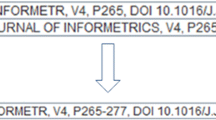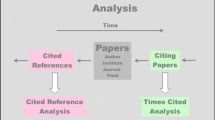Abstract
Commemorating the 100th death anniversary of Francis Galton, this paper is a bibliometric impact analysis of the works of this outstanding scientist and predecessor of scientometrics. Citation analysis was done in Web of Science, Scopus and Google Scholar (Publish or Perish) in order to retrieve the most cited books and journal articles. Additionally references were identified where Galton was rather mentioned than cited in order to analyze the phenomenon of obliteration by incorporation. Finally occurrence counts of Galton’s works in obituaries, Festschrift, the website Galton.org, major encyclopaedias and biographical indexes were compared to citation counts. As an outcome Galton’s works are increasingly cited or mentioned. Obliteration (use of eponyms) applies to one-third of Galton’s works and seems to be typical for fields like mathematics or statistics, whereas citations are more common in psychology. The most cited books and journal articles are also the most mentioned with remarkable correlation. Overall citation analysis and occurrence counting are complementary useful methods for the impact analysis of the works of “giants”.




Similar content being viewed by others
Notes
“Inquiries Human Faculty” is an exception, since “some chapters were reprints, while others expanded on topics alluded to in earlier articles” (Gillham 2001, p. 207).
References
Beddoe, J. (1911). Sir Francis Galton, D.C.L., F.R.S. Man, 11, 34.
Brockhaus-Enzyklopädie (1989) in 24 Bänden. - 19., völlig neu bearb. Aufl. Mannheim : Brockhaus.
Bulmer, M. G. (2003). Francis Galton: Pioneer of heredity and biometry (p. 376). Baltimore: Johns Hopkins University Press.
Cattell, J. M. (1906). American men of science: A biographical directory. New York: The Science Press.
Collier’s encyclopedia (1982) with bibliography and index. Ed. William D. Hallsey. - New York, NY [u.a.] : Crowell, Collier & Macmillan.
Corney, G. (1984). Sir Francis Galton, 1822–1911. Acta Geneticae Medicae et Gemellologiae, 33, 13–18.
Cronin, B. (1984). The citation process: The role and significance of citations in scientific communication. London: Taylor Graham. http://garfield.library.upenn.edu/cronin/citationprocess.pdf.
Cronin, B. (1995). The scholar’s courtesy: The role of acknowledgement in the primary communication process. London: Taylor Graham. http://garfield.library.upenn.edu/cronin/scholarscourtesy.pdf.
Enciclopedia Universal Ilustrada Europeo-Americana: etimologias sánscrito, hebreo, griego, latín, árabe, lenguas indígenas americanas etc.; versiones de la mayoría de las voces en francés, italiano, inglés, alemán, portugués, catalán, esperanto (1924). Madrid: Espasa-Calpe. ISBN: 84-239-4500-6.
Enciclopedia Italiana di Scienze, lettere ed arti. Roma: Istituto della Enciclopedia Italiana, 1.1929-36.1939; App.1.1938; 2.1938/48(1948), 2000.
Forrest, D. W. (1974). Francis Galton: The Life and Work of a Victorian Genius (p. 340). New York: Taplinger.
Galton, F. (1869). Hereditary Genius. London: Macmillan.
Galton, F. (1874). English Men of Science: Their Nature and Nurture. London: Macmillan.
Galton, F. (1883). Inquiries into Human Faculty. London: Macmillan.
Galton, F. (1908). Memories of My Life (p. 339). London: Methuen.
Garfield, E. (1975). The obliteration phenomenon. Current Contents, 51(52), 5–7.
Gieryn, T. F. (1980). Science and social structure: a festschrift for Robert K. Merton (pp. 147–157). New York: NY Academy of Sciences.
Gillham, N. W. (2001). A Life of Sir Francis Galton: From African exploration to the birth of eugenics (p. 416). New York: Oxford University Press.
Godin, B. (2007). From eugenics to scientometrics: Galton, catell, and men of science. Social Studies of Science, 37(5), 691–728.
Grand Dictionnaire Encyclopèdique Larousse. (1985). Paris: Librairie Larousse.
Gray, J. (1911). Sir Francis Galton, M.A., D.C.L., F.R.S. Born, February 16, 1822; Died, January 17, 1911. Man, 11, 33–34.
McCain, K. W., & McCain, R. A. (2010). Influence & Incorporation: John Forbes Nash and the “Nash Equilibrium”. Proceedings of the American Society for Information Science and Technology, 47(1), 1–2.
Merton, R. K. (1968). Social theory and social structure, enlarged edition. New York: Free Press.
Merton, R. K. (1996). On social structure and science. Chicago: University of Chicago Press. ISBN 0-226-52071-4.
Messeri, P. (1978). Obliteration by incorporation: Toward a problematics, theory and metric of the use of scientific literature. Unpublished manuscript. Columbia University.
Obituary. (1911). Sir Francis Galton D.C.L. D.Sc F.R.S. Journal of the Royal Statistical Society, 74(3), 314–320.
Obituary: Sir Francis Galton, F. R. S. (1911a). The Geographical Journal, 37, 3, 323–325.
Pearson, K. (1914–1930). The life, letters and labours of Francis Galton. Cambridge, England: Cambridge University Press. 1914–30. (3 (in 4) Vols.). Volume I. Birth 1822 to Marriage 1853; Volume II. Researches of Middle Life; volume IIIA. Correlation, Personal Identification, and Eugenics; volume IIIB. Characterization, Especially by Letters, and Index.
Poggendorff, J.C. (2004). Biographisch-literarisches Handwörterbuch der exakten Naturwissenschaften, Database, Completed Edition, Ed. Sächsische Akademie der Wissenschaften zu Leipzig, Wiley-VCH GmbH & Co. KGaA, DVD. ISBN 3-527-40322-1.
Price, D. J. de Solla (1963). Little Science, Big Science. New York: Columbia University Press.
Schwartz Cowan, R. (2004). Galton, Sir Francis (1822–1911). In: Oxford Dictionary of National Biography. Oxford University Press. Online edn (2005). http://www.oxforddnb.com/view/article/33315. Accessed 30 Jan 2011.
Swami, V., & Hernandeza, G. E. (2008). A beauty-map of London: Ratings of the physical attractiveness of women and men in London’s boroughs. Personality and Individual Differences, 45, 361–366.
The Encyclopedia Americana: in thirty volumes. Ed. in chief A. H. McDannald. - New York; NY [u.a.] : Americana Corporation (1965).
The New Encyclopaedia Britannica (2007). Jacob E. Safra, chairman of the board. 15th ed. Chicago, Ill. [u.a.] : Encyclopaedia Britannica.
Wikipedia English (2010) http://www.wikipedia.org.
Author information
Authors and Affiliations
Corresponding author
Rights and permissions
About this article
Cite this article
Gorraiz, J., Gumpenberger, C. & Wieland, M. Galton 2011 revisited: a bibliometric journey in the footprints of a universal genius. Scientometrics 88, 627–652 (2011). https://doi.org/10.1007/s11192-011-0393-y
Received:
Published:
Issue Date:
DOI: https://doi.org/10.1007/s11192-011-0393-y




